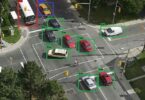In the broad and dynamic realm of machine learning, there’s a particular algorithm that catches the eye for its elegant simplicity and versatile application: k-nearest neighbors (KNN). The value of the machine learning sector standing by 2023 at an impressive 51.48 billion dollars, with projections to reach 771.38 billion dollars by 2032, suggests a great necessity to get familiar with such essential algorithms as KNN.
With this exponential growth, KNN gives a fundamental understanding of how machines learn from data, and it is a must-have for a newcomer in this field as well as an experienced practitioner. The following post outlines the principles, applications, and nuances of k-nearest neighbors, showing how this area takes part in shaping the future of artificial intelligence and machine learning.
Exploring Nearest Neighbor and K-Nearest Neighbors Algorithms
The nearest neighbor algorithm stands as a cornerstone in the exploration of data sorting and forecasting. It’s guided by the notion that similar items cluster together. Imagine a collection of points, each marked by distinct features, within a dataset. This method adopts a direct strategy: to classify a fresh point, it looks for the existing point nearest to it and assigns the newcomer to the same group as this closest peer.
Building on this basic premise, the k-nearest neighbors technique refines this strategy by not limiting the assessment to just one neighbor but instead ‘k’ closest neighbors. It scrutinizes the newcomer by examining the nearest points within the dataset. Subsequently, it decides the group for the new point based on the predominant category among these neighbors.
Key Components of K-Nearest Neighbors
Understanding the inner workings of KNN necessitates an exploration of its fundamental elements. Chief among these are the distance metrics. These metrics dictate the proximity between two data points within the feature space. Euclidean distance and Manhattan distance stand out as common examples, each catering to distinct scenarios.
Moreover, the choice of k holds paramount importance in determining the algorithm’s efficacy. Optimal selection of k entails striking a balance between bias and variance within the model. Lastly, the treatment of categorical variables proves indispensable in KNN. Transforming categorical variables into numerical representations ensures alignment with distance metrics.
Advantages of K-Nearest Neighbors
The straightforwardness of KNN presents several advantages. In contrast to numerous other algorithms, KNN does not necessitate a training phase. Consequently, upon obtaining your dataset, you can promptly employ KNN to categorize new data points.
Moreover, KNN is non-parametric, signifying that it makes no presumptions regarding the underlying data distribution. This adaptability permits KNN to accommodate various data types without necessitating intricate model modifications.
Limitations of K-Nearest Neighbors
However, despite its straightforwardness and versatility, k-nearest neighbors is not without its set of challenges. One notable drawback is its computational complexity, particularly evident when dealing with extensive datasets. As KNN scours for the closest neighbors, the time taken to compute distances scales up in direct correlation to the dataset’s size.
Furthermore, KNN proves to be sensitive to extraneous features and data noise. Incorporating irrelevant or noisy features can detrimentally affect the algorithm’s efficacy. Moreover, in spaces with high dimensions, the notion of distance loses its significance, resulting in compromised performance. To ease the load of computational intensity, tactics such as trimming down dimensions or turning to approximate nearest neighbor algorithms are frequently adopted.
Use Cases of K-Nearest Neighbors
Regardless of its inherent challenges, the k-nearest neighbors algorithm finds extensive application across numerous sectors. In tasks involving classification, wherein the objective is to assign labels to data points, KNN excels. Its straightforward methodology and efficacy render it a preferred choice for numerous classification challenges.
Likewise, in regression tasks aimed at predicting continuous values, KNN can provide dependable predictions. Additionally, KNN finds application in anomaly detection, a domain where identifying outliers or irregular patterns holds significance.
The versatility of KNN transcends conventional classification and regression tasks, rendering it apt for anomaly detection and other specialized endeavors. Moreover, its straightforward nature renders it accessible to practitioners from diverse domains, thereby fostering its widespread acceptance and utilization.
Practical Tips for Using K-Nearest Neighbors
In the application of KNN within real-world contexts, several pragmatic factors warrant attention. It is imperative to undertake feature scaling meticulously to mitigate the risk of features with substantial scales exerting undue influence on distance calculations. Moreover, ensuring the judicious handling of missing values is indispensable to prevent biases from permeating the outcomes.
Ultimately, the selection of a fitting distance metric assumes paramount importance and ought to be tailored to the idiosyncrasies inherent in the dataset. Adherence to established norms in preprocessing methodologies and parameter choice serves to bolster the dependability and efficacy of the KNN algorithm in practical settings.







